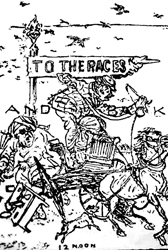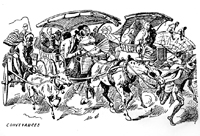|
|
||||
|
A ride back in time Horse racing and Galle Face esplanade
Today one leaves Colombo Fort via the ‘Galle Gate’ of the former Dutch Fort by the seaside in a southerly direction towards the fine open green popularly known as ‘Galle Face’ which has the sea on one side and the Beira Lake on the other. At the beginning of British rule, this esplanade extended the entire length of this plain, approximately one mile. Where in Colombo could one find a better site for recreation? The Europeans who lived in the Fort and Pettah spent their evenings at Galle Face enjoying the cool sea breeze sweeping across the Indian Ocean. The monotony of life in the Fort was eased in this environment by horse riding, walking and socialising.Before the Havelock Race Course at Colombo was established, race meetings were held in a cadjan - thatched oval bungalow which stood in the premises of the present Taj Samudra Hotel. This building was used as a Grandstand for horse racing. As horse racing became a popular pastime among the European residents in Colombo, the extensive open space in Galle Face provided a fine spot for the enthusiastic crowd.
The old Dutch fortifications to be seen at the northern end remained undemolished. The clock tower and the flash light were not there then. The view of northern end of Galle Face, therefore, was enriched only with the imposing Queen’s House or what we now call President’s House. This plain was gradually converted to a race course that was mainly to be approached by Slave Island on the west and or Kollupitiya on the south via a very narrow gravel road about twelve feet wide. Pedestrians scrambled over the grassy mounds and through the mangrove bushes by the lake or perhaps crossed in a ferry to come to the ground.
The earliest recorded races began in 1835 on September 22, and the Colombo Observer gave this lyrical description: ‘It was most gratifying to behold the fashion not only in Colombo but also from the other parts of the island collected at the Grand Stand where “Wit, beauty and elegance all did unite to charm the senses and dazzle the sight”. The leading newspaper of the day, Observer reported in 1837 the news of the death of King William IV that reached Colombo few days before the Colombo race meet. The racing was postponed and later the first day’s results were published with thick black borders. ‘Peroline’ was the first horse to win the Governor’s Cup twice, once in 1836 and again in 1837. This victory was not equalled for thirty four years till ‘Risk’ lifted the trophy in 1871 and in 1872. By 1853, horse racing in Galle Face had improved to the level of an Annual Meet where large crowds were assembled. As James de Alwis describes in his famous Sinhala verse Aœhvârôhana Varnanâva dated September 1, 1853, the festival commenced by early noon with the arrival of vendors of refreshments followed by ‘school boys who reached the spot and regale themselves on parched peas, seeni sakkara, and Bombay motai, etc. Employees took a day’s leave and arrived at the ground where they first enjoyed either a piece of sugar cane, veraloo achcharu (veralu pickle) or kurumba. Conjee too was a strange food made with sago partaken of under the tropical sun. Bombay syrup was the most popular cool drink available dressed in variegated colours. J. L. K. van Dort, the most famous nineteenth century artist had made a fascinating description of this racing meet in one of his manuscripts which was later reproduced in the ‘Times of Ceylon Annual’ in 1919. The following unchanged text would certainly recall the picture of this spectacular past event in the minds of readers. “An incessant stream of bullock carts, single and double, conveying family parties of the poorer natives from the suburbs came lumberingly along and camp on the borders of the lake. Overloaded ‘family bandies’ with ancient horses being urged or coaxed along, block up the way, while hackeries at a break-neck place come tearing along, ‘neck or nothing’ and scatter foot passengers and sweet meat passengers far and wide. Palanquin bearers with shutters down and curtains down, conveying Mohomadan ladies, and those of the Chetty community, take up an early position close to the roped off space; a rope doing a temporary duty in place of railings. No change being made for carriages, however, advantageously placed first come first served was the order of the day and accounted for these early arrivals. Later an occasional buggy on high springs could be seen zigzagging amongst the crowd, or a conveyance built after the pattern of the first American wagon which was introduced to Ceylon by the late Mr. Wilson of the defunct firm of Wilson Ritchie & Co. Mr. Wilson’s horses were always ridden on the course by Captain Barton of the Guards. Captain Price of the Commissariat rode his own horses, and his colours white and sky blue were often quite as victorious as the red and white of Captain Barton with the collar of his old fashioned jacket hiding the nape of his neck, cheeks, and ears and his equally old fashioned riding breeches reaching up to his arm pits was first favourite always and cheered everywhere. A marked feature of the Race Meet of the early years was the silence with which the native crowd looked on while the most exciting races came to a finish. The cheering was mostly confined to the European community in the vicinity of the ‘Race Bungalow’. The racers of the period were chiefly Arabs, with a stray Australian or Indian horse among them. The minor events were made up by ponies from Achren (present Atjeh in Sumatra) and Burmah (present Myanmar), some Indian tattoos and a few Ceylon-bred animals. Of professional jocks there were only two White (sons of old White the terrier and trainer) and an Indian jock, very popular with the natives. Officers of the garrison supplied the gentlemen riders. The saddling bugle always sounded at 4 p.m. sharp. The ropes were guarded by Gun Lascars (local soldiers) and Ceylon riflemen in undress uniform. The course was cleared by men on white chargers, wearing pink and white ‘top hats’ and wielding god whips with immense lashes, to terrorise now and again either a fat Nattucottaya Chetty, or an equally unwieldy Appu who would attempt to cross the course five seconds before the start. And then of course, there was the inevitable pariah dog that would run up and down the cleared course at the critical moment to the accompaniment of the unearthly shrieks and yells of enjoyment of the motley crowd. On one occasion, a buffalo cow broke loose from its grazing around by the lake and running wild, broke up the line at the starting post, just when the flag was about to fall, scattering the horses which bolted all over the field amidst great confusion. In those days, weighing scales were after the rude pattern of those on tripods, still (1890s) to be seen in some of the Pettah stores. The interval between each race was longer than it is now (1890s), and the time was profitably employed, not only at the temporarily improvised refreshment booths, but in open vehicles and on the roofs of carriages where gay groups discussed fizzing drinks infinitely superior to ginger-pop. On cup day, the Governor’s carriage would be seen approaching, with outriders in Lascoreen (native soldiers) uniform, their smart Repis (uniform) glittering with gold, and white horse hair plumes tipped with scarlet. On the box of the Governor’s carriage, beside the coachman, sat the attendant Lascoreen with the George IV helmet and plume, immense epaulets, coat with preposterously short tails, the high collar covering his ears; his hair knotted into the regulation konde (hair knot) with a high tortoise shell comb surmounting, and a waist band six inches in width encircling his body, up to his armpits almost. The band strikes up the National Anthem (to slow and solemn measure of the times) and the horses fretting within the narrow limits of the cadjan paddock are strutted out for parade. The band on duty was that of the Ceylon Rifles, in their smart uniforms of green and gold, their Repis surmounted with nodding black horsehair plumes. Herr Sommers was there as maestro and beside him were Sergeant Foulstone and Corporal O’Brien, both Madrasers while Potts, with his tenor drum loomed heavily in the distance and the African features of Beauchamp & Co. and Bacheho smiled on either side with their serpent and oboe; Malay boys acting as living bandstands.” It is believed that the Ceylon Turf Club was formed in the early 1850’s with a donation of £ 50 by Viscount Torrington (1847-50) towards 1848. Due to this initiative, the plain adjoining the Race Course was named after Viscount Torrington. The years between 1893 and 1914 was the most important period of the Ceylon Turf Club where it became a firmly established institution. Between 1919 and 1929 marked its most prosperous years by earning revenue of two to three hundred fold and as a result the Club embarked on a gigantic development programme. The old stand was replaced in 1923 by the structure that we see even today while passing Reid Avenue which has now lost its grandeur with shrubs grown on cracks of the original walls. During the prosperous years the track was improved making it faster and less hard. When the stakes were raised the income was enhanced handsomely and the Governor’s Cup brought with it Rs. 15,000 to the winner while the other classics were worth Rs. 10,000 each. As time passed, racing became less a sport and more a commercial and gambling proposition. The business spirit came into conflict with most other interests. When it reached the level of gambling it tended towards its natural death in the 1960’s. At this time the government then decided to ban horse racing in the whole island. |
||||
Copyright © 2006 Wijeya Newspapers
Ltd. All rights reserved. |

